
|
Noise in the Olympus E-500 |

|
My other articles related to the |
|
A significant percentage of questions I'm receiving about the Olympus E-500 camera concerns the noise: how much, how obtrusive, and what do I think about it? While I'm addressing the issue in a number on articles related to that camera, here is a set of samples and observations which can help in answering such questions. Before you continue reading, however, I would recommend having a look at my introductory article on this subject, just to get some general background. In particular, you have to understand the difference between random and fixed noise. This article is also applicable to the E-300 which uses the same KAF-8300 Kodak CCD sensor and, as far as I can tell, very similar in-camera image processing. It does not, however, apply to the E-1, E-330, and E-400, which have different sensors and, obviously, different processing schemes. Random noise: ISO 100 to 400 These are the basic ISO settings of this camera, intended for general use. As a subject I chose a can of green peas, shot early afternoon, and illuminated with daylight entering my patio door, facing east (open shade light, or close). Except for the ISO setting and Auto WB, I was using my standard E-500 preferences: Natural color mode with contrast at -1, sharpness at -2, and saturation at 0. I'm using these settings most of the time, as they allow for more freedom in image postprocessing. The exposure times were in all cases shorter than 1 s, therefore these samples illustrate only the random noise component; refer to one of the next sections to see about fixed noise, predominant at longer exposures. | ||
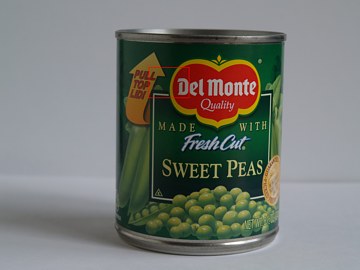
|
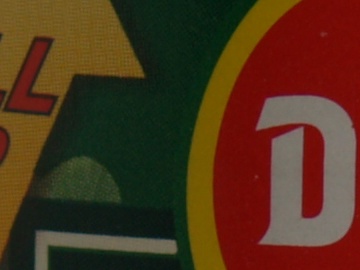
| |
|
[1] ISO 100, aperture priority (-0.3 EV): 1/4 s at F/8 | ||
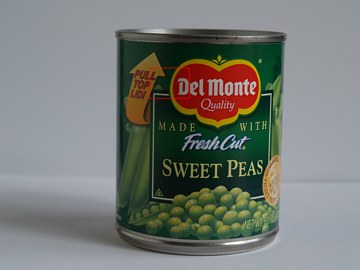
|
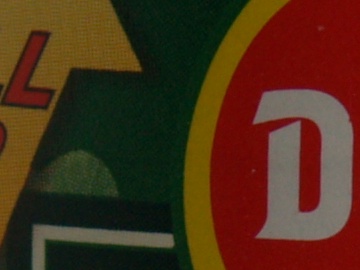
| |
|
[2] ISO 200, aperture priority (-0.3 EV): 1/8 s at F/8 | ||
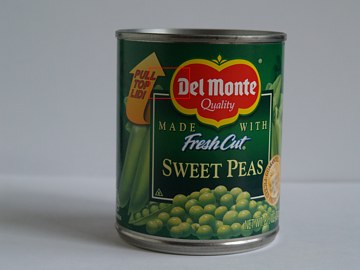
|
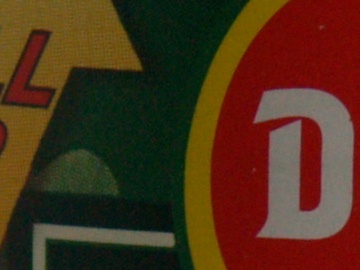
| |
|
[3] ISO 400, aperture priority (-0.3 EV): 1/13 s [sic!] at F/8 | ||
|
This is what I expected from my previous experience with the E-500: clean and nice; good enough for 12×16" (30×40 cm) prints. During the last year I've given up any qualms about shooting at ISO 400 whenever conditions may require that. Random noise at ISO 800 and 1600 These values are available in the E-500 as an option only if you activate the ISO Boost menu beforehand from the settings. This activation can be done in two ways: with or without extra noise filtering added in the in-camera postprocessing (some degree of such filtering is always present in the raw-to-RGB conversion; the Noise+NF option just makes it more aggressive). First, the samples without that option. | ||
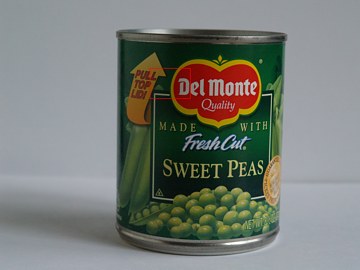
|
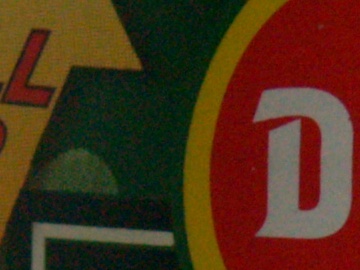
| |
|
[4] ISO 800, no NF, aperture priority (-0.3 EV): 1/25 s at F/8 | ||
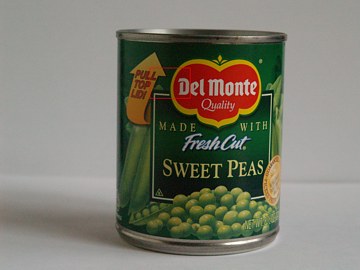
|
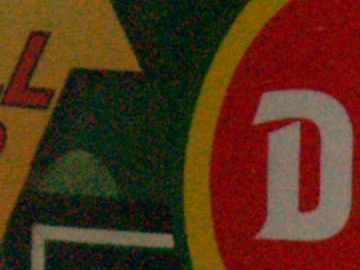
| |
|
[5] ISO 1600, no NF, aperture priority (-0.3 EV): 1/50 s s at F/8 | ||
|
Surprisingly, even is some noise is already visible at ISO 800, it is not really bad. At ISO 1600, however, things start looking quite ugly, at least for those of us who have been spoiled with smooth digital images (back in the film era, an ISO 1600 film with a comparable grain effect would have been considered a big deal). Importantly, the contrast and tonality of images seem to hold steady in the ISO 100-800 range; at ISO 1600 the image seems to be a bit flat and gets a yellow tint (which seems to be a rule). ISO 800 and 1600, NF on As mentioned above, every sensor exhibits some noise, and every camera (or a raw-to-RGB conversion program) applies some degree of filtering to it. Companies like Olympus and Nikon chose to apply as little of it as possible, to avoid undesirable side-effects (including, but not limited to, texture extinction); some others, notably Canon, are not afraid to apply more aggressive filtering. In the E-500 Olympus allows to enable a stronger noise filter for ISO of 800 and higher. There are also third-party noise removal applications, available stand-alone or as Photoshop plugins. Some people prefer to use those, as the process can be more easily tweaked to a particular image this way; also, a modern computer has more CPU power than a camera, and therefore filtering algorithms can be more sophisticated. What follows now are the samples for ISO 800 and 1600 processed with the in-camera noise filter and with the Neat Image, which is my favorite noise removal application. Original samples are also repeated, to make the comparison easier. | ||

|
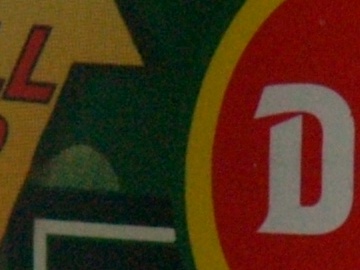
| |
|
[4] ISO 800, NF off (same as [4] above) |
[6] ISO 800, NF on; exposure like in [4] | |
|
First, ISO 800. Note that the image [4] above still shows the print texture next to the "L" at the left (no, this is not banding or Moiré pattern). The in-camera filtering (above right) removes some noise, but the yellow pattern remains largely intact; a conservative and right decision. The picture processed by the Neat Image (right) is very smooth, and the contours remain sharp, but the yellow texture is gone. I'm not blaming the program: many textures look very much like noise, and the only way to preserve them is to apply less filtering. The preset I've used in [4a] seems a bit too strong for my liking; the in-camera filtering may be just right here. |
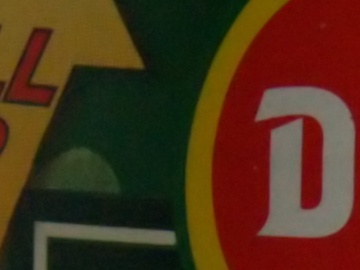
| |
|
[4a] ISO 800, NF off, Neat Image applied to [4] | ||

|
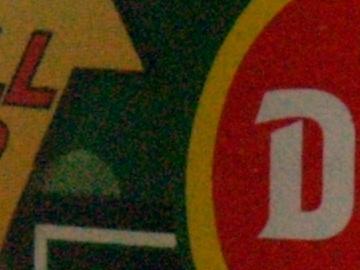
| |
|
[5] again: ISO 1600, NF off |
[7] ISO 1600, NF on; exposure like in [5] | |
|
At ISO 1600 the yellow print texture is long gone, being covered by noise in the original image [5] above. This is why the image [7], with in-camera filtering (above right) does not really lose much of what it starts from. It is generally better, except that the noise clusters in the red background are replaced with out-of-focus blobs. Still, more usable. [5a], processed with Neat Image (right) is smoother, and some will prefer it over [7]. The noise in the dark-green background is almost gone, but the red looks like it was painted over. The contours also suffer a bit; One may argue, again, that I should have used a less aggressive profile. |
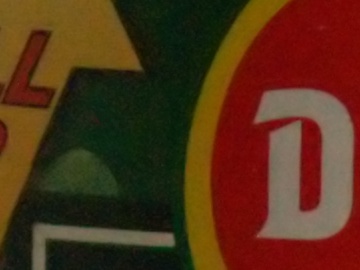
| |
|
[5a] ISO 1600, NF off, Neat Image applied to [5] | ||
|
Random noise dependency on exposure time Based on the common sense, the dynamic noise at a given ISO setting should not depend on the exposure time: after all, to provide the correct exposure, the number of photons reaching the photosite remains the same. If there is less light, you must use a slower shutter, so that the product of the illumination of the image plane and exposure time remains constant. To check that, I shot a number of sequences with varying shutter speeds, at various ISO settings. The results, at least as viewed with naked eye, seem to confirm this hypothesis, Here are two ISO 1600 samples shot at tungsten (halogen) light, with Reference WB, no noise filtering, and all other settings as before. | ||
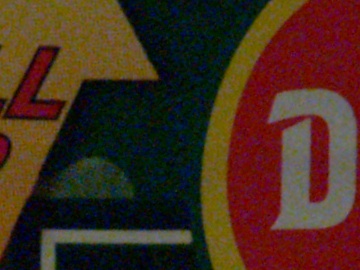
|
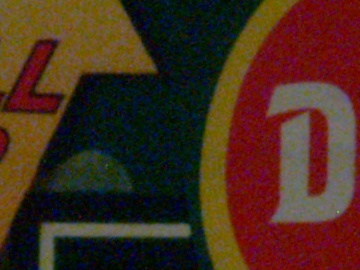
| |
|
[8] ISO 1600, tungsten light, no NF, aperture priority (0 EV): 1/15 s s at F/5.6 |
[9] ISO 1600, tungsten light, no NF, aperture priority (0 EV): 1 s s at F/22 | |
|
While this series answered one question, it also raised another: why is the noise in these images significantly less than in those shot under daylight? Compare either of these two with [5] above; there is no doubt about that. Actually, under tungsten the ISO 1600 images are quite presentable! This was the last thing I expected doing this comparison. Just for the record, similar samples shot at ISO 800. Compare them to [4] shown earlier. Again, these are clearly better — more of the tungsten magic? | ||
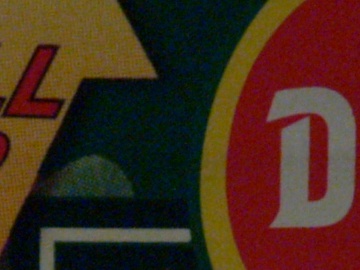
|
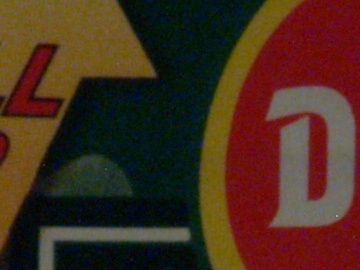
| |
|
[10] ISO 800, tungsten light, no NF, aperture priority (0 EV): 1/8 s s at F/5.6 |
[11] ISO 800, tungsten light, no NF, aperture priority (0 EV): 2 s s at F/22 | |
|
Note the white hot pixel seen in the 'D' letter in both right-hand samples above. This is related to the fixed noise issue, discussed in the next section. When exposure time gets longer, the other noise component creeps in: the fixed noise, which is due to differences in individual pixel responsiveness to light (see my Noise 101 again). With modern sensors, this effect begins visible only at shutter speeds longer than one second or so, and this is why the (optionally activated) noise reduction in the E-500 kicks in only at exposures of four seconds or longer; at shorter ones the camera will not use it, even if the feature is turned on. This noise reduction (not to be confused with noise filtering, discussed above) is performed by subtracting a "dark frame" (i.e. signal recorded at the same exposure time but without any light reaching the sensor) from the original image before the RGB conversion. For a gives sensor gain (ISO setting), fixed noise significantly increases with the exposure time. Actually, my test shots are showing that it depends on the product of that time and the ISO value. Here are some samples supporting this claim, together with a demonstration how the subtractive noise reduction works: | ||
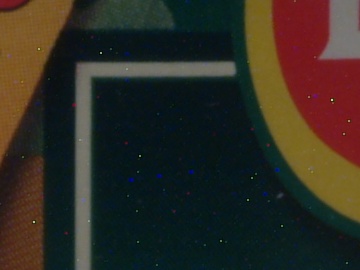
|
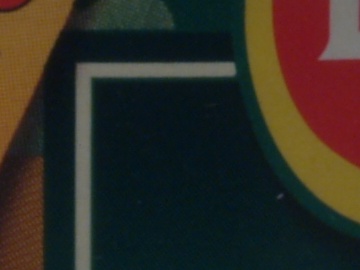
| |
|
[12] ISO 100, tungsten light, aperture priority: 50 s at F/22, no NR |
[13] Same as [12], but NR on | |
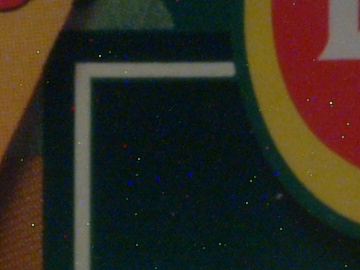
|
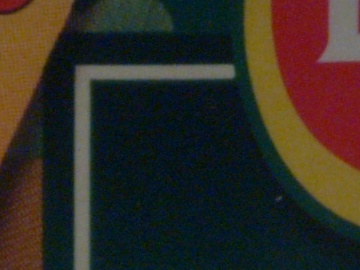
| |
|
[14] ISO 400, tungsten light, aperture priority: 12.5 s at F/22, no NR |
[15] Same as [14], but NR on | |
|
Indeed, the fixed noise in [12] and [14] looks identical, at least as far as hot pixels are concerned. (The same was confirmed for ISO 800 and 1600, except that the spikes were slightly reduced by the random noise filtering, which I have left turned on.) Obviously, the fixed noise does not depend on the aperture (neither does the random noise); after all, the sensor does not know or care about it; it is just the sensor gain and exposure time which count here. I have used F/22 in this experiment just to be able to get long exposures under my interior ceiling lights; additionally I had to use a polarizing filter in lieu of a neutral density one. As we can see in the right-hand samples, the noise reduction does a very good job with the fixed noise, at least regarding the high-amplitude component. Still, I have to disagree with one decision by Olympus designers: making use of fixed NR only at exposures of four seconds or longer. First of all, I would like to see this limit somewhat lower: 2 s at ISO 100, because that's when the first hot specks start appearing. More importantly, this limit should be ISO-dependent: halved at ISO 200, halved again at ISO 400, etc. While the first point is, to some extent, a matter of taste, the second is not: at higher ISOs the effect starts earlier, and this should be accounted for. The pitfalls of pixel-peeping When viewing image samples on a computer screen in full pixel size, we have to remember that all image flaws are exaggerated. To show the full frame in this scale, your 90 dpi screen would have to be 27×36 inches (about 69×92 cm). You do not view such an image from a distance of 16 inches! In addition, screens show lots of contrast; more than any print. Remember this gorgeous girl you met back in college? You would have never dated her, had you have seen her skin under a microscope, magnified 100 times... | ||
|
To bring things into proportion, I printed my daylight ISO 800 and 1600 samples on a premium glossy paper, 8.5×11" (net image size of 8×10.6", or 20×27 cm). While I have done some high-ISO printing in the past, this was the first time I actually compared different versions of the same picture, and this is what made the experiment interesting. Here are my impressions: |
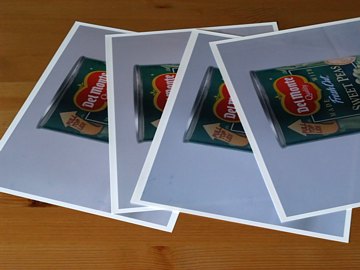
| |
These are just words, and different people use words differently. Your definitions of "passable" or "nice" may be different than mine; your expectations can be higher or lower. This is why I'm providing the original, unaltered files used in the (daylight) high-ISO comparison; feel free to download and print them to draw your own conclusions, just have mercy on my bandwidth:
Note that these images did not undergo any explicit postprocessing other than noise reduction with NeatImage in [4a] and [5a]; in particular, no tonal equalization or sharpening has been applied. Noise filtering in postprocessing This subject really deserves a separate treatment, so here are just a few quick notes. First of all, if you decide to go this way, then have the in-camera filtering off. Let the external application deal with the "raw" noise (or almost so, in view of my remarks above), not one already smoothed out once. Second, the choice of the denoising application. After trying out a number of those about three years ago, I settled down on the Neat Image. It does the job the right way, allows you to use as much or as little manual adjustment as you feel comfortable with, and feels just right in details (and I'm pretty hard to please regarding software, as you may already know). I have no doubts recommending this application. You can download a non-expiring demo version of Neat Image from the developer's Web site. The trial is limited mostly regarding saving capabilities: it writes only low-compression JPEGs and does not preserve the embedded EXIF information — good enough for trying it out and for occasional use. If (or rather: when) you are convinced that the program does what you need, you may buy it. Four versions are available, rather confusing, but there is a table comparing their capabilities. I paid $75 for the top Pro+ version: "Pro" adds support for 48-bit color (useful when denoising images being converted from raw, before translating them into 24-bit JPEGs), and "Plus" versions include, along with a stand-alone executable, a PhotoShop plugin, which works also with many other image-processing programs, including Photo-Paint, Paint Shop Pro, and Photoshop Elements. The number of adjustments in Neat Image may be somewhat overwhelming for uninitiates (like myself), but you can always ask the program to auto-calibrate the process to the image you are working with. Another option is to use one of the camera profiles (different for each ISO settings) developed by other users and available from the distribution site. The profiles used in this comparison were developed by Gordon Wheaton (thanks!) and they seem to be optimized for printing, which is just what I need. There are a number of other programs performing the same job; among those the Noise Ninja has a dedicated following, but the demo version is not really useful: it overlays a grid over saved images. While this is enough to see how it works, you do not get a freebie for an occasional use. One of the reasons Neat Image got my money was that I was able to use the free version successfully to improve some of my night ISO 320 shots from the E-20. This way I was able to learn how to use and appreciate the program. A better selling strategy, I would think. Noise removal options built into image-processing programs are usually less capable. In particular, in the Corel Photo-Paint X3 this feature is just useless; it does not seem to work at all at any settings (the same as in earlier versions). It works in Paint Shop Pro, but a far cry from Neat Image. I haven't tried noise removal in the Photoshop, as I use that program only if I must. Conclusions To add things up, at ISO up to 400, the E-500 does not suffer from excessive noise at all. I have no problems using ISO 400 even if I don't have to — for example, in street photography under overcast skies. At ISO 800 the noise becomes visible, and at ISO 1600 — objectionable. Surprisingly, there is less of it under tungsten illumination than in daylight, and the difference is clear. Still, I was able to get presentable 8x11" prints at ISO 1600 with the built-in noise filtering or, better, the Neat Image. The amount of extra noise filtering provided by Olympus at ISO 800 and higher seems to be a bit on the conservative side, but reasonable. If you agree, set the ISO Boost option in the Settings 1 to On+NF; ISO 800 will be OK, if not spectacular, and ISO 1600 at least usable. If you would like to reduce the noise even more, use just the On setting (no NF), and apply denoising in the postprocessing stage with a third-party application. Of those, Neat Image has my recommendation. | ||

|
My other articles related to the |
|
Evolt® and Olympus® are registered trademarks of Olympus Corporation.
This page is not sponsored or endorsed by Olympus (or anyone else) and presents solely the views of the author. |
| Home: wrotniak.net | Search this site | Change font size |
| Posted 2006/11/21 | Copyright © 2006 by J. Andrzej Wrotniak. |